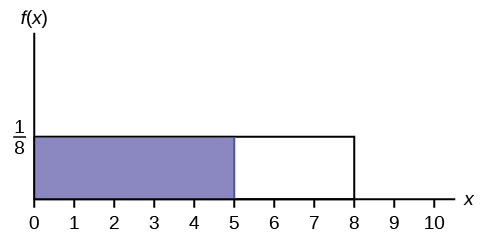5.E: Ejercicios
- Page ID
- 153270
5.1: Introducción
5.2: Funciones de probabilidad continua
¿Qué tipo de distribución ilustra la gráfica?

Distribución Uniforme
¿Qué tipo de distribución ilustra la gráfica?

¿Qué tipo de distribución ilustra la gráfica?

Distribución Normal
¿Qué representa el área sombreada? P (___< x < ___)

¿Qué representa el área sombreada? P (___< x < ___)

P (6 < x < 7)
Para una distribución de probabilidad continua, 0 ≤ x ≤ 15. ¿Qué es P (x > 15)?
¿Cuál es el área bajo f (x) si la función es una función de densidad de probabilidad continua?
uno
Para una distribución de probabilidad continua, 0 ≤ x ≤ 10. ¿Qué es P (x = 7)?
Una función de probabilidad continua se restringe a la porción entre x = 0 y 7. ¿Qué es P (x = 10)?
cero
f (x) para una función de probabilidad continua es 1 5
, y la función está restringida a 0 ≤ x ≤ 5. ¿Qué es P (x < 0)?
f (x), una función de probabilidad continua, es igual a 1 12
, y la función está restringida a 0 ≤ x ≤ 12. ¿Qué es P (0 < x < 12)?
uno
Encuentra la probabilidad de que x caiga en el área sombreada.

Encuentra la probabilidad de que x caiga en el área sombreada.

0.625
Encuentra la probabilidad de que x caiga en el área sombreada.

f (x), una función de probabilidad continua, es igual a 1 3
y la función está restringida a 1 ≤ x ≤ 4. Describir P (x > 3 2 ) .
La probabilidad es igual al área de x = 3 2
a x = 4 por encima del eje x y hasta f (x) = 1 3
.
Tarea
Para cada problema de probabilidad y percentil, dibuje el cuadro.
Considera el siguiente experimento. Eres una de las 100 personas alistadas para participar en un estudio para determinar el porcentaje de enfermeras en América con un título R.N. (enfermera registrada). Le preguntas a las enfermeras si tienen un título de R.N. Las enfermeras responden “sí” o “no”. Después se calcula el porcentaje de enfermeras con título R.N. Le das ese porcentaje a tu supervisor.
- ¿Qué parte del experimento arrojará datos discretos?
- ¿Qué parte del experimento arrojará datos continuos?
Cuando la edad se redondea al año más cercano, ¿los datos permanecen continuos o se vuelven discretos? ¿Por qué?
La edad es una medida, independientemente de la precisión utilizada.


